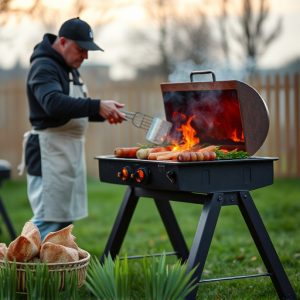- Understanding the Ideal Doneness for BBQ Salmon
- Preparing Your Grill for the Perfect Cooking Environment
- Choosing the Right Cut and Seasoning Techniques
- Direct vs Indirect Heat: When to Use Each Method
- Mastering the Timing for Flaky, Juicy Results
- Simple Sauces and Toppings to Elevate Your BBQ Salmon
- Tips for Cleaning and Storing Leftovers
Understanding the Ideal Doneness for BBQ Salmon
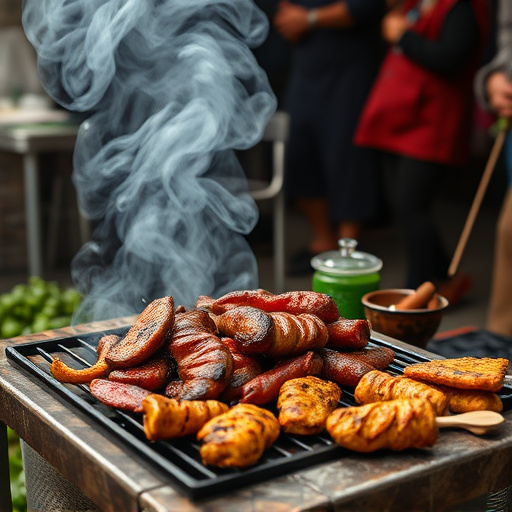
When it comes to cooking salmon via barbecue techniques, understanding the ideal doneness is key to a mouthwatering BBQ salmon recipe. Aim for a medium-rare to medium level of doneness—this ensures the salmon stays moist and flavorful while achieving that delightful pink center often sought after by BBQ enthusiasts. The internal temperature should reach approximately 125°F (52°C) for the best results, allowing the fish to retain its natural juices and tender texture.
This precise cooking method preserves the salmon’s delicate taste, transforming it into a true star of your barbecue spread. Whether grilled or smoked, this technique ensures that each bite is perfect—flaky, succulent, and bursting with BBQ essence.
Preparing Your Grill for the Perfect Cooking Environment
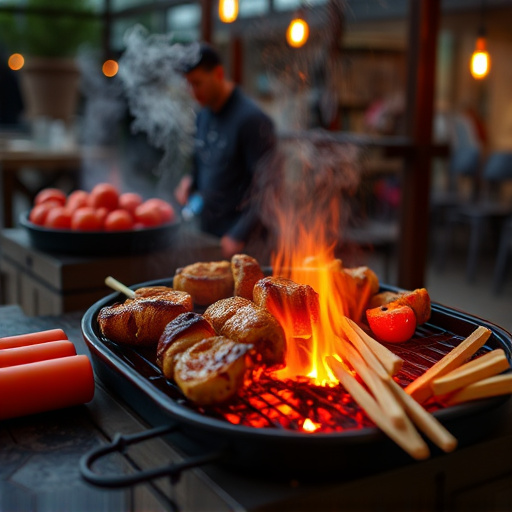
To cook salmon to perfection using barbecue techniques, preparing your grill is a crucial step. Start by ensuring even heat distribution across the grill grates. Clean the grill and grease it lightly to prevent sticking. Preheat your grill to medium-high heat, allowing it to reach approximately 400-450°F (200-230°C). This temperature range is ideal for searing the salmon’s surface while maintaining its moistness. Consider using a meat thermometer to monitor the internal temperature of the grill and ensure consistent cooking.
For a successful BBQ salmon recipe, direct and indirect heat play complementary roles. Place the salmon fillets on the hot side of the grill for searing, creating a crispy crust. After a couple of minutes, move them to the cooler side or cover the grill to finish cooking. This method seals in the juices, resulting in succulent, flakey salmon. Remember to flip the fillets once halfway through the cooking process to achieve even browning and ensure the interior cooks evenly.
Choosing the Right Cut and Seasoning Techniques
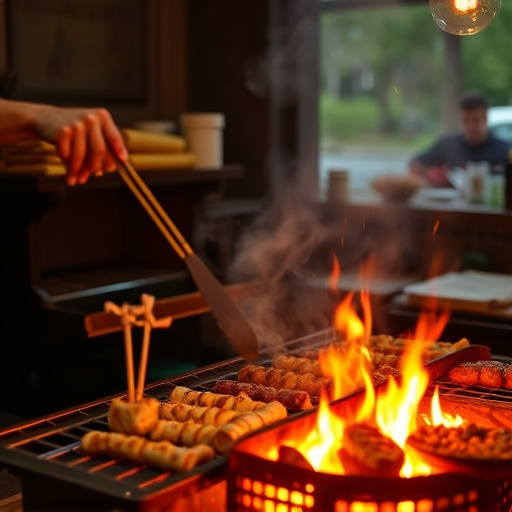
When it comes to cooking BBQ salmon recipes, selecting the right cut is half the battle won. For perfect results, opt for a thick fillet or steak-cut salmon. These cuts ensure even cooking and retain moisture, resulting in a tender and succulent dish. The key is to choose a size that will fit your grill grate comfortably, allowing for optimal heat distribution.
Seasoning plays a vital role in enhancing the natural flavors of salmon. A simple yet effective method is to rub the fish with salt and pepper before grilling. For an extra kick, consider a dry rub blend of spices like paprika, garlic powder, and dried herbs. Marinades are another excellent way to infuse moisture and aroma; try a combination of olive oil, lemon juice, and fresh herbs for a zesty twist. Experimenting with these seasoning techniques will elevate your BBQ salmon from ordinary to extraordinary.
Direct vs Indirect Heat: When to Use Each Method
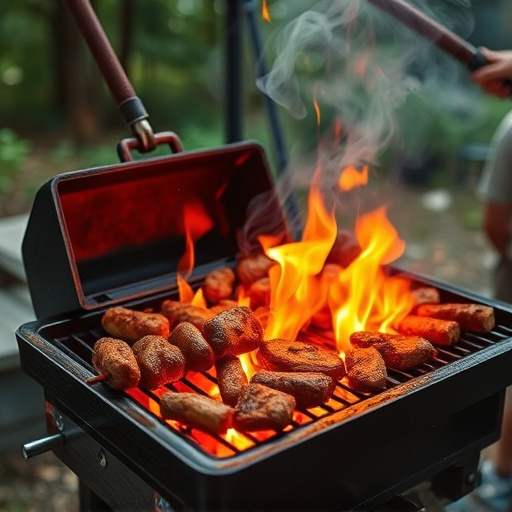
When it comes to cooking salmon to perfection using barbecue techniques, understanding direct and indirect heat methods is key. Direct heat involves grilling the fish directly over high, hot coals or a burning gas flame. This rapid heating method seals in juices and creates a crispy skin while keeping the flesh moist. It’s ideal for thicker cuts of salmon like fillets or steaks, as it ensures even cooking without overcooking the exterior.
Indirect heat, on the other hand, uses lower temperatures and a barrier to cook the fish. This gentle approach is perfect for thinner pieces of salmon or when you want to infuse flavors with smoke. Indirect heat allows the fish to cook slowly, ensuring a tender, flakey texture. Many BBQ enthusiasts prefer this method for creating a subtle smoky flavor that enhances the natural taste of the salmon. For a delicious bbq salmon recipe, consider these contrasting heat techniques to achieve your desired culinary result.
Mastering the Timing for Flaky, Juicy Results

Mastering the timing is key when cooking salmon on the barbecue for that perfect, flaky texture and juicy flavor. Timing ensures the internal temperature reaches the ideal range, resulting in a mouthwatering dish. For a bbq salmon recipe, aim for an internal temperature of 125°F to 135°F (52°C to 57°C). This range guarantees that the fish cooks thoroughly without overcooking, maintaining its moisture and delicate structure.
A good rule of thumb is to grill salmon for about 4-6 minutes per inch of thickness on each side, depending on your preferred doneness. Rare to medium-rare (125°F) salmon will be slightly translucent in the center with a few pink areas, while well done (145°F) will have no trace of pink. Regularly checking the temperature with a meat thermometer ensures you achieve the desired results for a perfect bbq salmon recipe every time.
Simple Sauces and Toppings to Elevate Your BBQ Salmon
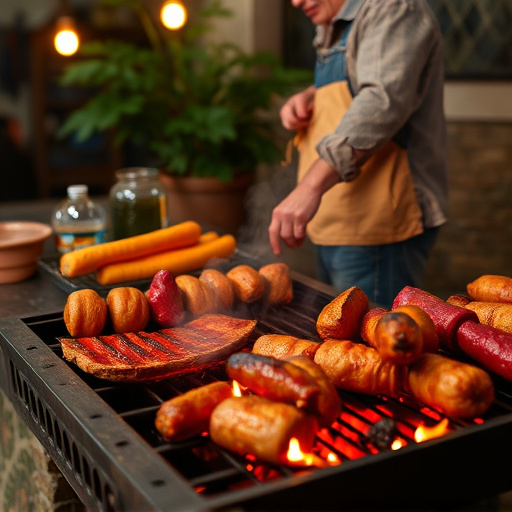
Cooking BBQ salmon can be elevated with simple sauces and toppings that complement its rich flavor. A classic choice is a drizzle of lemon-dill sauce, made by whisking together lemon juice, minced dill, olive oil, salt, and pepper. This refreshing sauce adds brightness and herbality to each bite. For a sweet and smoky twist, try a glaze made from brown sugar, soy sauce, and a touch of chili paste. Brush this on the salmon during the last few minutes of cooking for a caramelized exterior and juicy interior.
Toppings like grilled vegetables, such as asparagus or bell peppers, add texture and color to your plate. Crumbled feta or fresh herb garnishes, including chopped parsley or cilantro, lend extra flavor and visual appeal. Even a simple sprinkle of sea salt and freshly ground black pepper can take your BBQ salmon recipe from good to great, balancing the flavors and highlighting the natural goodness of the fish.
Tips for Cleaning and Storing Leftovers
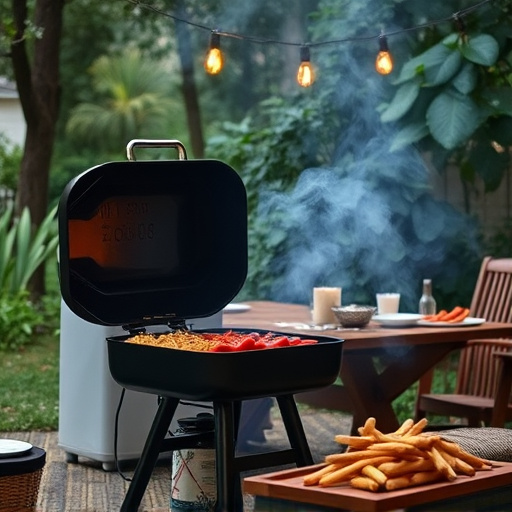
When it comes to grilling BBQ salmon, proper cleaning and storage practices are key to ensuring both food safety and maintaining the deliciousness of your creation. After cooking, allow the salmon to rest for a few minutes before handling. This allows juices to redistribute, keeping the fish moist and flavorful. To clean the grill, use a soft brush or paper towels to remove any leftover chunks of salmon or charred residue, preventing them from tainting future meals.
For storing leftovers, place cooled salmon in an airtight container or wrap it tightly in plastic wrap or foil. Store it in the refrigerator for up to 3 days or freeze for longer periods. Make sure to label and date your containers for easy identification. When reheating, you can grill or bake the salmon again for a quick and tasty repeat of your BBQ salmon recipe.
